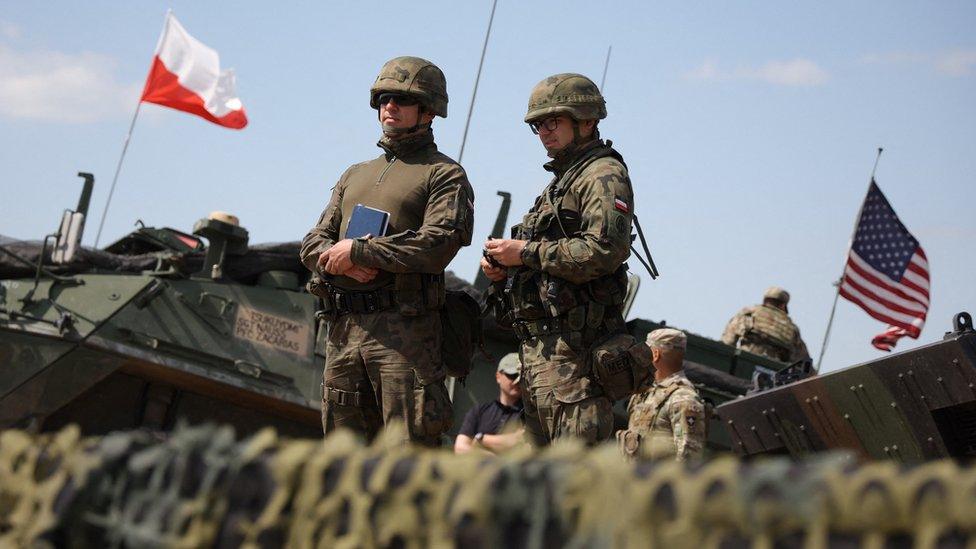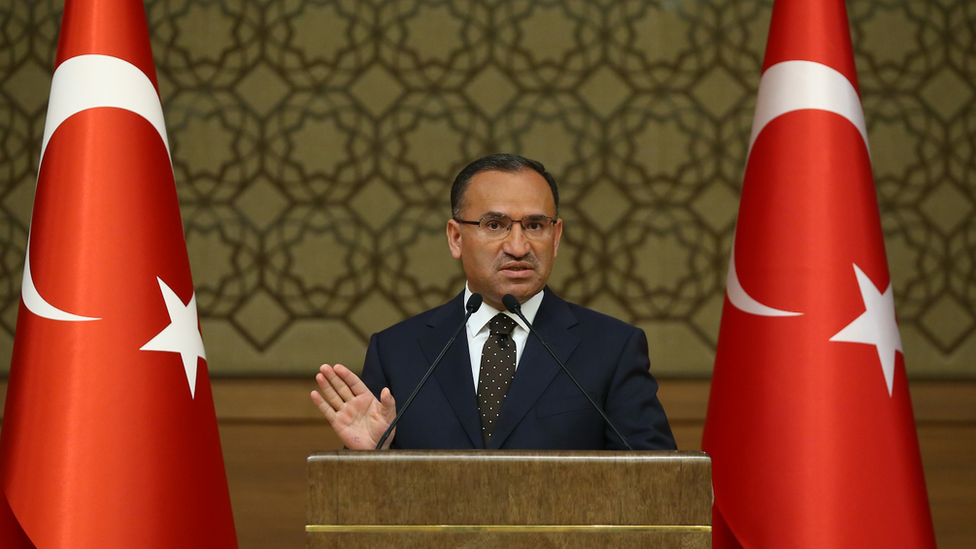Ukraine war: US to ramp up military presence across Europe
- Published

The US president said this was "exactly" what Russian President Vladimir Putin did not want
The US will increase its military presence across Europe as Nato agreed a "fundamental shift" in its response to Russia's invasion of Ukraine.
A permanent army headquarters will be created in Poland, while new US warships will go to Spain, fighter jets to the UK and ground troops to Romania.
Mr Biden said Nato was "needed now more than it has ever been".
The alliance is having its biggest overhaul since the Cold War, Nato head Jens Stoltenberg said.
The new plan in response to Russia's invasion will mean more than 300,000 troops at high readiness next year, up from the current level of 40,000.
Mr Biden told a summit in Madrid that Nato would be "strengthened in all directions across every domain - land, air and sea".
The UK's Ministry of Defence (MoD) has also said it is significantly increasing the availability of forces to Nato's collective defence, with more warships, fighter jets and land forces on standby - although the MoD said it would not give details on numbers as they are "militarily sensitive".
The US announcement sees it shore up its presence across the continent but particularly in eastern Europe where the new permanent headquarters for its 5th Army Corps will be based.
Mr Biden repeated the alliance's commitment to "defend every inch" of its territory, saying: "We mean it when we say an attack against one is an attack against all."
The measures include:
Boosting the fleet of US naval destroyers in Spain from four to six
An additional "rotational brigade in Romania consisting of 3,000 fighters and another 2,000-personnel combat team
Two more squadrons of F-35 stealth jets to the UK
Additional air defence and other capabilities in Germany and Italy.
The UK has already nearly doubled the size of its military presence in Estonia, with just over 1,600 troops there.
More will be allocated to the defence of the Baltics, however the MoD said these additional troops may be held at high readiness back home.
At the summit Nato leaders agreed to accept the previously neutral Nordic states Finland and Sweden into the alliance, with their membership needing to be ratified by the governments of all 30 Nato members.
Mr Biden said this was "exactly" what Russian President Vladimir Putin did not want and said his strategy of invading Ukraine had backfired.
Nato Secretary General Mr Stoltenberg said Finland and Sweden had been formally invited to join the military alliance, describing it as the "fastest accession process ever", and said he expected the swift progress to continue.
The two applicants must now show that they meet Nato's standards in politics, law, and in their armed forces - something which is expected to be relatively straightforward for the Nordic countries.
Mr Stoltenberg said Ukraine could continue to count on the alliance's assistance in the face of Russian aggression for "as long as it takes", adding that Ukraine was fighting for its independence but also for values shared by Nato.
He said member states had agreed a "comprehensive assistance package" for Ukraine, which included fuel, medical supplies, body armour, anti-drone systems and equipment to counter mines.


Gone are the past mealy-mouthed references to Russia or China being partners.
In an 11-page document, Nato's updated Strategic Concept, external explains how the alliance views the threats facing western democracies and how it plans to deal with them.
The Russian Federation, it says, is the most significant and direct threat to allies' security and to peace and stability in the Euro-Atlantic area.
We cannot consider it "to be our partner", it reads, but "we remain willing to keep open channels of communication with Moscow" to prevent escalation.
The deepening strategic partnership between Russia and China runs counter to Nato values and interests, the document explains.
In reference to President Putin's repeated reminders that he's got a large arsenal of nuclear weapons, Nato points to its own formidable nuclear deterrent.
If anyone used nuclear weapons against the alliance, the document says, then it has the capabilities and resolve to impose "unacceptable" costs on an adversary. But these circumstances, it adds, are "extremely remote".
The document is short on detail of where Nato plans to place its reinforcements.
But its door remains open to new members, it says, and in words that will further annoy the Kremlin: "We will continue to develop our partnerships with Bosnia and Herzegovina, Georgia and Ukraine."

The summit described a new guiding blueprint for the alliance which said that Russia was "the most significant and direct threat to Allies' security and to peace and stability in the Euro-Atlantic area".
It added that "we cannot discount the possibility of an attack against allies' sovereignty and territorial integrity".
Mr Putin said he could not rule out that tensions would emerge between Russia and Sweden and Finland after they joined Nato and said Moscow would respond in kind if Nato infrastructure was set up in the countries.
He said Nato leaders wanted to "assert their supremacy, their imperial ambitions" but also said Russia had "no problem" with Finland and Sweden joining the bloc.

- Published11 July 2023

- Published29 June 2022

- Published27 June 2022